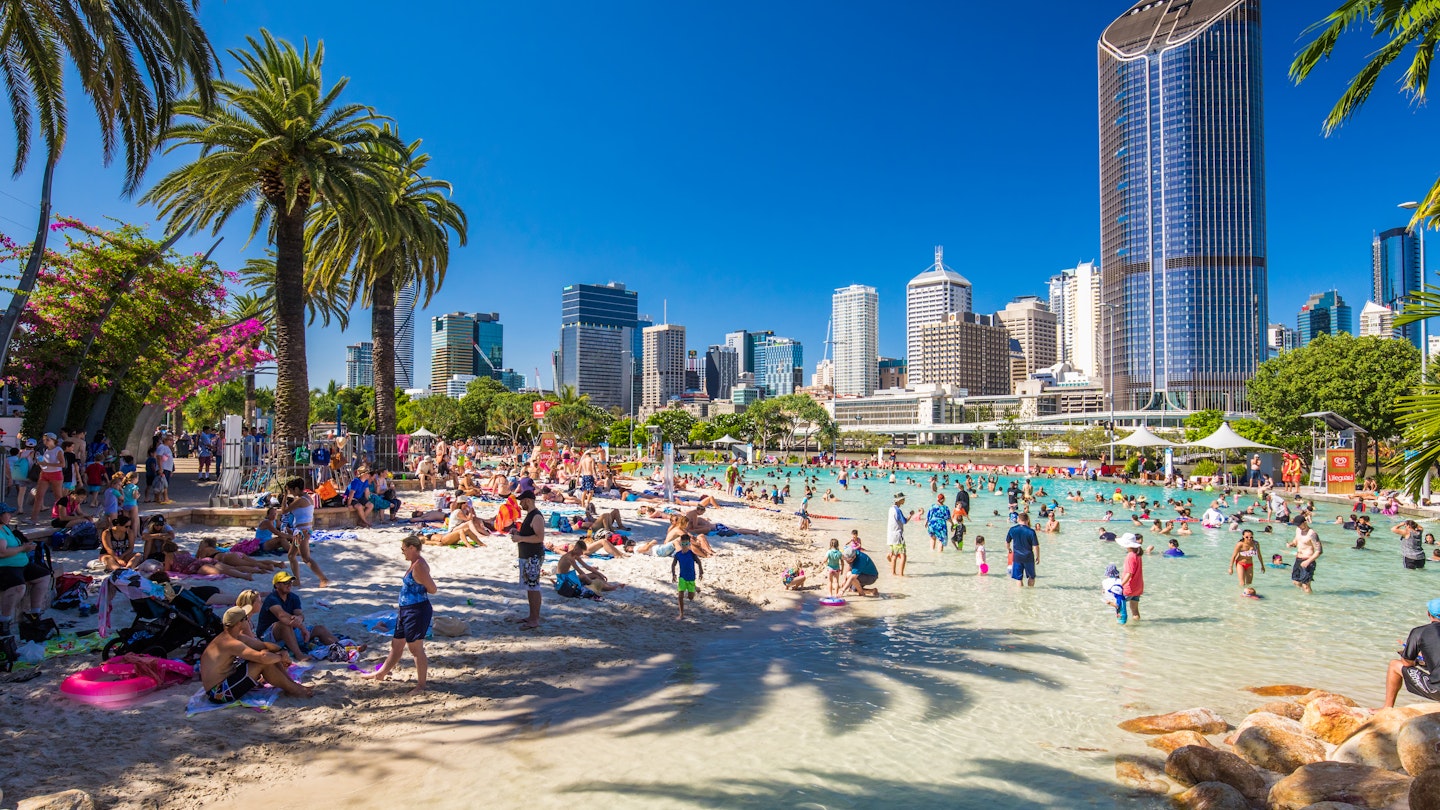When to Visit Brisbane: Optimal Times for Sunshine and Events
Subtropical Brisbane’s fantastic weather is one of its biggest claims to fame. The city enjoys around 280 days of sunshine each year, and it never gets really cold – even in July, Brisbane’s coldest month, daytime temperatures range from 11–23°C.
However, it does get humid in this part of Queensland. At the height of the Australian summer, from December to February, the city can feel uncomfortably sticky, and big thunderstorms sometimes roll in at the end of the day. For travelers coming from the northern hemisphere winter, that’s a small price to pay, and you can always cool off on the coast or at Brisbane’s city beach.
It shouldn’t be entirely surprising that the busy season in Brisbane is during the cooler and drier months. This is when most large events are scheduled, making it the most comfortable time to be in town, yet still warm enough to swim and enjoy the sunshine.
High Season (May–September & January): The Best Time for Sunshine and Festivals
The Australian winter is the peak season for Brisbane, characterized by reliable sunshine and minimal rain. The best festivals are held at this balmy time of year, especially in May and September. Temperatures are warm but not overwhelming, typically rising to around 26°C (79°F) and rarely dipping below 11°C. You’ll still want to wear T-shirts during the day, but pack long sleeves for the evening.
From June to August, Australia’s southern inhabitants often escape to Queensland to escape the cold. During school holidays (which vary by state in June/July and across September), it’s advisable to secure accommodations and domestic flights well in advance.
January, a swelteringly hot and humid month in Brisbane, remains a travel high season due to school summer holidays. Temperatures can reach 45°C (113°F), with frequent heavy rain, yet the city remains full of holidaying families, making early planning crucial for accommodation and activities.
Shoulder Season (March–April & October): Good Weather with Smaller Crowds
The Australian spring and autumn shoulder seasons offer ideal conditions for visiting Brisbane. At the end of March, the uncomfortable heat and humidity finally ease, with temperatures dropping to a more manageable 15–25°C (59-77°F). Additionally, travel prices typically decrease from their winter peak, except during the Easter school holidays.
From October, mild days gradually warm; sunny skies are complemented by refreshing sea breezes, and the heavy rains have yet to arrive. This month is also excellent for festivals, as the city becomes vibrant with celebratory activities.
Low Season (November–December & February): Ideal for Budget Travel
The Australian summer marks the low season in Brisbane, except for the January school holidays when prices peak. This period is known for hot and humid conditions along with frequent rain. Average temperatures range from 22°C (72°F) to 30°C (86°F) and can reach higher, with monthly rainfall that can be three times the winter average.
Despite the weather, it’s a fantastic time to find accommodation bargains, and the dramatic thunderstorms can be captivating if you appreciate nature’s elements. It also represents peak surf season in Southeast Queensland, and every third year, the Asia-Pacific Triennial of Contemporary Art showcases incredible exhibits, particularly from December to April.
January
During this period, all of Australia’s schoolchildren seem to be visiting Queensland, with crowds and accommodation prices soaring, especially at family-friendly attractions.
Key events: Uncaged Festival
February
With school back in session, Queensland experiences a slight reprieve. However, high temperatures and peak humidity (65-70%) persist.
Key events: BrisAsia Festival, Queensland Cabaret Festival
March
As the heat and humidity begin to recede, excellent accommodation deals become available with fewer tourists around.
Key events: Brisbane Ice Cream Festival, Weird Science Festival Brisbane
April
This is Brisbane’s sunniest month, ideal for visitors. Although Easter can see a surge of tourists, the warm weather is perfect for beach trips and outdoor activities.
Key events: Oceania Cycling Championships, Redcliffe Festival of Sails
May
As the weather becomes pleasant, festivals begin to flourish in the city. It’s an excellent time to experience Brisbane.
Key events: Brisbane Comedy Festival, Paniyiri, Brisbane Street Art Festival, MELT Festival of Queer Arts & Culture, Anywhere Festival, Brisbane Gin Festival, Brisbane Writers Festival
June
From June to October, Humpback whales migrate offshore. Pricing tends to spike during the June/July school holidays.
Key events: Brisbane Marathon, Out of the Box Festival
July
Typically the coldest month, temperatures rarely dip below 11°C at night; a light sweater is advisable.
Key events: State of Origin
August
This sunny month features a public holiday for the Royal Queensland Show, known as the Ekka.
Key events: The Ekka, Bridge to Brisbane
September
With fantastic weather and premium events aligned with school holidays, September stands out. The Brisbane Festival attracts large crowds, particularly for the Riverfire fireworks finale – early reservations are recommended.
Key events: Brisbane Festival, NRL Grand Final, Bigsound Festival
October
This festival-filled month brings warmth and the beauty of jacarandas blooming throughout the city.
Key events: Valley Fiesta, Oktoberfest, Brisbane International Film Festival, Brisbane Portrait Prize, Brisbane Shakespeare Festival, Brisbane Pride Festival
November
As temperatures rise, thunderstorms and increasing humidity shape the weather.
Key events: Wynnum Fringe
December
Brisbane ushers in the summer solstice and Christmas with blazing hot, humid days, typically accompanied by thunderstorms and an influx of tourists.
Key events: Moonlight Cinema, Wildlands





